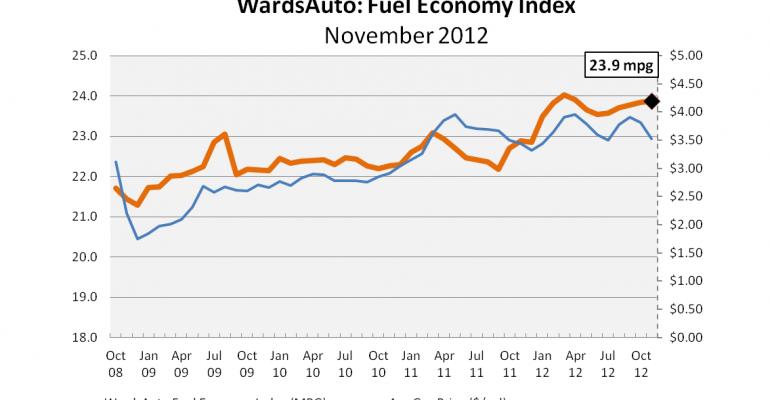One month after recording its highest score on the WardsAuto Fuel Economy Index, Ford raised the average efficiency rating of its November light-vehicle deliveries an additional 3.4% to 23.8 mpg (9.9 L/ 100 km).
Ford’s gain represents a 12.3% improvement over year-ago, and a whopping 25.4% jump from its base-index rating set in fourth-quarter 2007.
The average fuel economy of all U.S. new light vehicles sold in November was 23.9 mpg (9.8 L/ 100 km), a 14% improvement over the Index’s baseline.
Ford’s recent rise comes largely as a result of hybrid and plug-in hybrid versions of its new C-Max cross/utility vehicle and Fusion sedan.
During the 5-year period ending in September, combined hybrid- and electric-vehicle sales averaged only 1.4% of Ford’s monthly light-vehicle total. That rose to 2.9% in October, the first full month of hybrid C-Max and Fusion sales, and reached 4.1% in November.
Year-to-date, alternatively powered (electrified) vehicles make up 3.3% of all industry U.S. LV sales, compared with 2.2% in all of 2011.
With the C-Max and Fusion hybrids and Focus EV rated well above the 21.2 mpg (11.1 L/100 km) average for the rest of Ford’s fleet, a small bump in sales of the electrified models can have an outsized effect on the auto maker’s overall fuel economy.
The C-Max and Fusion are rated at 47 and 45 mpg (5 and 5.2 L/100 km), respectively, and the C-Max plug-in and relatively new Focus EV both are listed at more than 100 mpg (2.35 L/100 km), although the Environmental Protection Agency revealed this week it is investigating whether those fuel-efficiency claims are overstated.
Toyota has averaged a 15.6% hybrid/EV mix since January, during which time the auto maker has had sole possession of the top spot on the WardsAuto index. Its November score of 27.2 mpg (8.6 L/100 km) marks a 2% improvement from year-ago.
Volkswagen finished second on the list for the 11th consecutive month, with a focus on traditional small and midsize cars and diesel powertrains. On average, alternatively powered vehicles make up less than 1% of the German auto maker’s monthly sales.
For the second month since the EPA announced it was downgrading the fuel-economy ratings for numerous recent Hyundai and Kia models, both auto makers failed to rank among the Index’s top five.
Finishing ahead of the Korean brands were Mazda, which earned a company-best 26.1 mpg (9 L/100 km); Honda, which scored 26 mpg (9 L/100 km); and Mitsubishi, recording its best-ever rating, 26 mpg (9 L/100 km).
CUVs were the best-selling segment in October, accounting for more than 25% of all LV sales for the first time since July 2011, while averaging 22.1 mpg (10.6 L/100 km).
Small-cars earned a 29.6 mpg (7.9 L/100 km) average with 19% of the market, outselling midsize cars for the second time in three months.
The Midsize segment earned its best index rating ever, 28.5 mpg (8.2 L/100 km), while accounting for 18.9% of LV sales.
The WardsAuto FEI November tally matched the second-highest score to date, lifting the industry’s 11-month rating 4.9% over year-ago to 23.8 mpg (9.8 L/100 km).





